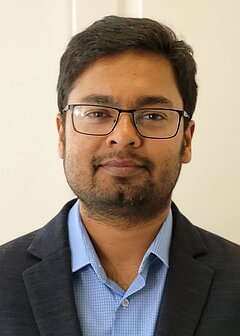Bappaditya Chandra
Assistant Professor
Research Interest(s)
Exploring Nature's Droplet Factories in Health and Disease
Conventionally we know that Protein’s unique shape gives it a unique function. However, some proteins defy this convention—they don’t adopt fixed structures or shape. Instead, imagine a protein that's more like a flexible strand of cooked spaghetti rather than a meticulously folded origami. Recent discoveries suggest these "floppy" regions in proteins might help them to form liquid droplet-like structures inside cells. Just as oil droplets in water, proteins and nucleic acids in our cells can create specialized droplets that act as cellular control centers. This process known as, "liquid-liquid phase separation," and the resulting droplets are known as "biomolecular condensates", are like tiny biological factories where important cellular reactions take place. In our lab, we study how these molecular droplets influence health and disease, particularly in cancer.

Office: Sugihara 306
Phone: (701) 231-5556
Email: bappaditya.chandra@ndsu.edu
Ph.D.
Tata Institute of Fundamental Research, Mumbai, India
Postdoc
St. Jude Children’s Research Hospital
External Links
Google Scholar Link
The Chandra Lab
Why This Matters
Imagine a city's emergency response system – police, firefighters, and medical teams that rapidly mobilize when needed and disperse once their job is done. Our cells follow similar dynamic organization system, creating temporary "emergency response centers" through droplet formation, rather than relying solely on permanent structures. These dynamic liquid-like compartments form rapidly when needed and dissolve when their task is complete, just like how emergency teams gather at a crisis site and disperse afterward.
In cancer cells, these dynamic response systems are often hijacked – imagine emergency teams being misdirected or assembling at the wrong places at the wrong times. This disruption of normal cellular organization can drive disease progression. Our research aims to understand how these cellular "emergency response systems" work normally and what happens when they malfunction in diseases like cancer. By understanding these processes, we hope to develop new therapeutic strategies – essentially finding ways to restore proper cellular organization and response systems.
Our Research Focus
We're particularly interested in special proteins called transcription factors that control gene activity. Think of these as the cell's master controllers – they decide which genes get turned on or off. Many of these controllers have flexible, "shape-shifting" regions that allow them to form droplets-like structures which can control cellular signaling processes. When mutations occur in these regions, it can lead to various diseases, including different types of cancer.
These control centers are fascinating because they work like cellular command posts, gathering multiple proteins and molecules together to coordinate gene regulation. Just as a conductor coordinates an orchestra to create harmonious music, these droplet-forming transcription factors orchestrate complex patterns of gene activity. When mutations disrupt this process, it's like having a conductor giving wrong signals to the orchestra – the resulting chaos can drive disease development.
Our research investigates how these molecular conductors normally work, what happens when they malfunction, and how we might develop new therapies by targeting these droplet-forming processes. By understanding these fundamental mechanisms, we aim to find new ways to treat diseases where gene regulation goes awry.
Current Projects
Our lab currently explores several exciting directions:
- How protein droplets drive cancer progression
- The role of viral proteins in manipulating cellular droplets
- Understanding droplet formation in genetic disorders
- Developing Bio-materials using the concepts of protein-nucleic acid phase separation
Our Approach
We use cutting-edge technologies to watch these droplets form in real-time inside living cells, including:
- Advanced microscopy to visualize droplet formation
- Protein engineering to understand droplet properties
- Mass spectrometry to identify droplet components
- Computational analysis to predict droplet behavior
Impact
Our research aims to:
- Discover new ways to treat cancer and genetic diseases
- Understand fundamental cellular organization
- Design innovative therapeutic strategies
By combining basic science with practical applications, we're working to unlock new possibilities for treating diseases by targeting these cellular droplets. Our interdisciplinary approach brings together physics, chemistry, and biology to tackle these complex challenges.


